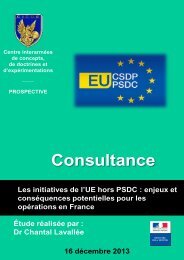Conference
science-research-bulletin-2013-conference
science-research-bulletin-2013-conference
Create successful ePaper yourself
Turn your PDF publications into a flip-book with our unique Google optimized e-Paper software.
EUROPEAN POLICE SCIENCE AND RESEARCH BULLETIN<br />
SPECIAL CONFERENCE EDITION<br />
A BRIEF HISTORY<br />
Women have been present and engaged in<br />
the work of policing for over a century now.<br />
Participating in various forms of social control<br />
for much of the nineteenth century (in various<br />
‘moral rescue’ roles), female police officers were<br />
first recruited in the early twentieth century.<br />
As the century progressed, their appointment<br />
continued on a piecemeal basis. In a rare<br />
international comparison of the progress and<br />
integration of women in policing, Van Ewijk<br />
(2012, p1) notes four broad phases of women’s<br />
recruitment into policing: after the First World<br />
War; the Inter-War years; after the Second World<br />
War; and the modern period from the 1980s<br />
onwards. Despite variation between countries, a<br />
consistent and familiar pattern of recruitment is<br />
observed, whereby there is a ‘period of omission,<br />
followed by limited succession, amalgamation<br />
or formation of separate women’s departments<br />
and working towards full integration’. Alongside<br />
this pattern of recruitment, commentaries on<br />
early policewomen’s experiences suggest much<br />
opposition and resistance. Histories document<br />
a damning picture in which women’s entry and<br />
progression was vigorously fought, resisted and<br />
undermined on legal, organisational, informal<br />
and interpersonal levels (Carrier, 1988; Martin,<br />
1980; Miller, 1999; Schulz, 1995; Segrave, 1995).<br />
Whilst countries vary in the dates that women<br />
were admitted into the police, there is a strong<br />
consensus that suggests that opposition to their<br />
entry and integration was almost universal (Brown,<br />
1996). In making sense of this opposition, Brown<br />
and Heidensohn (2000) point to a combination<br />
of paternalistic concerns to protect women<br />
and patriarchal exclusion of women as being<br />
unsuitable for the ‘rough and dirty tasks’ required<br />
by policing. Perhaps best described as a history<br />
of struggle, the history of women in policing is<br />
one in which clear and strong gendered markers<br />
of inclusion and exclusion were established. From<br />
the very outset, the role and identity of the police<br />
officer was firmly located within men’s domain<br />
and associated with ideas of masculinity. With<br />
physicality and the capacity to use coercive force<br />
crafted as something that only men possessed,<br />
women were constructed and deemed to be<br />
‘deficient’ in the project of mainstream policing<br />
and routinely and legitimately excluded. Cast as<br />
‘outsiders’ to the main project of policing, early<br />
policewomen’s presence in policing was enabled<br />
only through a focus on social and welfare work<br />
tasks, working with female suspects and victims of<br />
crime (mainly those engaged in prostitution) and<br />
young people (Brown et al, 1999; Heidensohn,<br />
1992; 2000; Brown & Heidensohn, 2000; Schulz,<br />
1995).<br />
As the century progressed, the appointment of<br />
women in policing continued on a piecemeal<br />
basis with Brown (1996) reminding us that though<br />
political activation and lobbying contributed<br />
to changing attitudes towards the idea and<br />
possibility of women police officers, their actual<br />
entry was often precipitated by a ‘crisis’. Europe<br />
for example, saw a growth in the number of<br />
policewomen after the two world wars; as did Asia<br />
and Africa in the post-colonial era and emerging<br />
democracies in Eastern Europe and South America<br />
(Van Ewijk, 2012); and India, following the crisis<br />
brought about the mass movement of people<br />
following Partition in 1947 (Mahajan, 1982). The<br />
influence of such ‘crisis’ based discourse holds<br />
much continued resonance to contemporary<br />
calls for the need to recruit more women into<br />
policing. The reality of trafficking problems in<br />
newly emerging African nations for example, is a<br />
key impetus for the recruitment of more women<br />
into policing. Important changes brought about<br />
by Equalities policy and legislation throughout<br />
established democracies in Western Europe, the<br />
US and Australia have also contributed much<br />
to the progression of women into mainstream<br />
policing in latter part of the twentieth century<br />
(Brown, 2007; Natarajan, 2008).<br />
Women in England & Wales began their work<br />
in policing in a separate women’s sphere in the<br />
Women’s Police Service (WPS). It was only in<br />
1975 that the police organisation disbanded<br />
the WPS and integrated women into its ranks.<br />
The idea that integration would automatically<br />
improve women’s situation and bring about<br />
equality however, did not materialise. Relatively<br />
little was done to prepare the police service to<br />
become a gender-integrated organisation in the<br />
aftermath of the Sex Discrimination Act 1975 and<br />
much has been written about the disjuncture<br />
between policy and practice in the decades that<br />
followed, with studies reporting discrimination<br />
and sexual harassment as consistent features of<br />
policewomen’s experiences. Sexist jokes, the<br />
use of derogatory language, deliberate sexual<br />
contact, differential deployments, blocked<br />
promotions, and the allocation of ‘safer’ station<br />
assignments are all indicative of women’s<br />
discriminatory experiences of policing over the<br />
course of the twentieth century (see Brown,<br />
1997 for a good review of this). Conceived of<br />
as a moment of progress and gain for women,<br />
144





